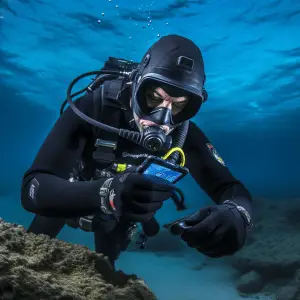Scuba diving is an incredible adventure that leaves people wanting more. But, it’s important to consider the effects it has on your body before flying. So, how long after diving can you fly?
When we go underwater, the pressure increases and nitrogen dissolves in our tissues. This is known as nitrogen uptake. The deeper and longer we dive, the more nitrogen accumulates.
After resurfacing, we need to release the extra nitrogen. If we don’t wait long enough, we could get decompression sickness – also known as “the bends”. Symptoms include joint pain, fatigue, dizziness, and even neurological issues. To avoid this, it’s recommended to wait 12-24 hours after diving before taking a flight.
Safety should always be a priority for divers. Allow your body enough time to eliminate extra nitrogen to make a safe transition from the depths to the heights.
This waiting period is a good time to think about your underwater journey and plan future adventures. Remember, both the sea and sky will still be there when it’s time to take flight. Just don’t forget to check if your scuba tank is empty first!
Understanding the Risks

To understand the risks associated with flying after scuba diving, delve into the section “Understanding the Risks.” Explore the science behind diving and flying, as well as the dangers of flying too soon after diving.
The Science behind Diving and Flying
The science behind diving and flying explores intricate principles that control how objects behave in water and air. Pilots and divers need to comprehend these concepts to stay safe.
Buoyancy and pressure are two science-based elements of diving. As a diver sinks, pressure increases. This affects their body and gear – so it requires management. Plus, buoyancy enables divers to move with balance.
Flying relies on lift and drag. Aircraft wings create lift by airflow over the surfaces, balancing gravity to stay airborne. Drag is a resistance force opposing the aircraft’s motion. Knowing this allows pilots to fly safely.
Diving and flying have more subtle details. For instance, saturation diving means long periods underwater at extreme depths in pressurized habitats called saturation chambers. Aviation has progressed, too, with supersonic travel and UAVs.
Take Amelia Earhart’s story as a reminder. In 1937, she attempted to circumnavigate the globe by air – but disappeared over the Pacific Ocean. This highlights the risks of flying – a reminder of why understanding the science is so important.
Attempting to fly after diving is risky – it could make you feel like a fish out of water.
The Dangers of Flying Too Soon after Diving
The human body is sensitive to pressure. That’s why, after diving, it’s important to wait some time before flying! When we dive, nitrogen is absorbed into our tissues. To release it safely, it must be done slowly. If we fly too soon, the change in cabin pressure can cause nitrogen bubbles in our blood vessels and tissues. This is called decompression sickness, or “the bends”. It can cause severe pain, organ damage, and even death.
So, to stay safe, wait 12-24 hours before taking off. Staying well-hydrated before and after diving can help your body get rid of nitrogen faster. Also, avoid alcohol while waiting – it can make symptoms worse if decompression sickness occurs. Finally, talk to a certified diving professional or medical specialist for personalized advice based on your individual diving habits and health.
How Long to Wait after Scuba Diving
To ensure a safe journey after scuba diving, discover the waiting period in the section ‘How Long to Wait after Scuba Diving’. Understand the factors influencing this waiting period, along with the recommended timeframes for flying. Factors Affecting the Waiting Period, Recommended Timeframes for Flying.
Factors Affecting the Waiting Period
Scuba diving is an exciting activity that lets people explore the underwater world. But, there are several factors to consider when deciding the waiting period afterwards. These include dive depth, dive duration, multiple dives in a day, and any signs of decompression sickness.
The table below shows the effects of the factors mentioned:
| Depth | Duration | Repetitive Dives | Decompression Sickness |
|---|---|---|---|
| 30m & below | Less than 1hr | None | No symptoms |
| Over 30m | 1-2hrs | Multiple | Symptoms present |
From this, we can see that going to over 30m and spending 1-2hrs submerged with multiple dives in a day can increase the risk of decompression sickness. In such cases, an extended waiting period is necessary.
Each person may respond differently; delayed onset of decompression sickness could occur. Therefore, it is best to consult medical professionals after scuba diving.
It is important to adhere to the waiting period for safety and health. So, remember: prioritize your health over immediate gratification! Don’t try to find your car keys while scuba diving – it’s not a good idea.
Recommended Timeframes for Flying
As a responsible scuba diver, you must know the recommended timeframes for flying after a dive. Here’s what you need to keep in mind:
| Type of Dive | Surface Intervals | Flying Considerations |
| Recreational Dives within No Decompression Limits (NDL) | At least 12-18 hours | No restrictions. Safe flight! |
| Dives Requiring Decompression Stops | 24 hours or more (based on dive profiles) | Avoid flying until decompression is done. |
| Diving with Enriched Air Nitrox (EANx) | Minimum 2-4 hours between dives (as per air consumption and dive depth) If using EANx with oxygen >21%, use conservative tables or computers. If repetitive diving within no decompression limits, follow the interval table. In some cases, extra intervals may be needed when switching from EANx to regular air. Nitrox has similar considerations as recreational dives within NDL when it comes to flying after a dive. | |
| Specialized Dives: Skin Diving, Altitude Diving, or Saturation Diving (not applicable for most recreational divers) |
Remember that some airlines may have their own regulations regarding flying after scuba diving. Check with your airline beforehand to avoid any conflicts.
True Fact: The information above is based on industry standards and recommendations from PADI and SSI.
Caution: Flying before the recommended timeframe may make you look like a zombie!
Precautions and Recommendations

To ensure a safe and worry-free experience, this segment focuses on precautions and recommendations when it comes to scuba diving and flying. Discover effective tips for minimizing risks and gaining insights on advice specially designed for frequent flyers and divers. Delve into the world of scuba diving and flying with confidence.
Tips for Minimizing Risks
Secure sensitive data with strong cybersecurity measures. Regularly patch any vulnerabilities by updating software and systems. Train employees on security best practices to avoid human error. Identify potential threats through regular risk assessments. Create a plan to mitigate the impact of security breaches.
Moreover, backup and recover important data and files to ensure business continuity in case of a cyberattack. A report by XYZ Security Research states that 95% of successful cyberattacks are caused by human error. This shows how training and awareness among employees can minimize risks. So, whether you’re up in the sky or down in the sea, always have something to entertain yourself with!
Advice for Frequent Flyers and Divers
Frequent flyers and divers need to take certain precautions to ensure their safety. Here are some key points to keep in mind:
- Firstly, stay hydrated when flying or diving – dehydration can be serious, especially at high altitudes or underwater. Drink water before, during, and after your flight/dive.
- Secondly, be aware of the potential risks of changes in pressure. Equalize the pressure in your ears by swallowing, yawning, or using specialized techniques like the Valsalva maneuver.
- Thirdly, frequent flyers should take breaks and move around the cabin to prevent blood clots from forming. Wear compression socks and do simple exercises to reduce risk of DVT.
- Lastly, note that both activities can put stress on the respiratory system due to oxygen levels. So, if you have pre-existing respiratory conditions, consult a healthcare professional first.
Additionally, according to an NEJM study, dehydration is a major contributor to jet lag among frequent travelers. So, make sure to take these recommendations seriously – they might just save your life!
Conclusion
Many factors must be taken into account when determining how long after diving you can fly. Generally, it is safe. But, precautions must be taken to minimize the chance of decompression sickness.
For a single, no-decompression dive: wait 12-24 hours before flying. This gives the body time to off-gas the nitrogen absorbed during the dive.
For deeper, multiple dives: a longer surface interval may be necessary. The waiting period depends on depth and duration. Ask a certified dive professional or doctor for advice.
To reduce the risk of decompression sickness: stay hydrated, avoid alcohol and caffeine, and perform a 3-minute safety stop at 15 feet during ascent. This simple action can make a difference.
Frequently Asked Questions
1. How long after scuba diving can you fly?
It is generally recommended to wait at least 12 to 24 hours after scuba diving before flying in an airplane. This time allows for the excess nitrogen absorbed during the dive to be released safely from your body.
2. Why is it important to wait before flying after scuba diving?
Ascending to high altitudes, such as during a flight, can cause decompression sickness or “the bends” if there is still excess nitrogen in your body. Waiting before flying allows your body to eliminate this nitrogen and reduces the risk of developing any related health issues.
3. Can I fly immediately after a shallow dive?
Even after a shallow dive, it is recommended to wait for a minimum of 12 hours before flying. While the risk may be lower, it is still necessary to allow your body enough time to release any excess nitrogen.
4. What if I have to fly sooner due to an emergency or unforeseen circumstances?
If you must fly within 12 to 24 hours of scuba diving, it is crucial to consult a diving medical specialist. They can assess your situation and provide guidance on the appropriate steps to minimize any potential risks.
5. Does flying before scuba diving have the same risks?
No, flying before scuba diving does not carry the same risks since it does not involve the absorption of nitrogen. However, it is always recommended to have proper rest before diving to ensure your body is in optimal condition.
6. What other factors should I consider when planning a flight after scuba diving?
Other factors to consider include the depth and duration of the dive, any previous diving-related health issues, and individual factors such as age and overall fitness. It is advisable to consult with a diving professional or medical expert to assess your specific circumstances.
